Optical tweezers use a beam of laser light to trap, hold and manipulate small objects, such as nanoparticles or cells. The technique is non-invasive and does not damage the object under study. At the focus point of the laser, the particle experiences a net force towards the centre of the beam, such that the particle is trapped and will move together with the laser beam. The laser is focussed using a microscope such that the manipulated object is simultaneously imaged. Besides from manipulation, the optical tweezer can also be used to quantify e.g. attractive forces between cells.
What are the sample requirements?
The sample requirements depend largely on the experimental design, however here are some guidelines:
- Samples for Optical Tweezers must be pure.
- Sample volume is about 100 uL.
- Sample concentration: Bring a stock solution of 1 mg/ml
What other specific considerations are relevant?
- The instrument is especially suited for (but not restricted to) studies of protein interactions with nucleic acids or cytoskeletal filaments, conformations of nucleic acids, protein folding and conformational changes or liquid-liquid phase separation.
- Due to the wide diversity of possible samples, it is always good first to discuss the possibilities and limitations of the optical tweezer for a certain type of experiment and sample with the TNA site.
Partners offering this technique
MOSBRI reference partner site for this technique:
Other partners:
